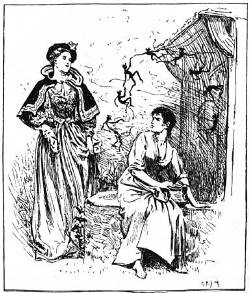In the comments following my post on YA fairy tale fiction, contributor Patrick Garson remarked that we can’t know the “original” meanings of fairy tales that have been transmitted through the oral tradition. It’s not until a version has been recorded—or composed, in the case of literary tales like those by Marie-Catherine d’Aulnoy or Hans Christian Andersen—that a text exists to which subsequent storytellers can respond.
Thinking about this point, I realized that my fairy tale novels are less like a conversation and more like an argument with established canon. Stories I already love don’t provoke me enough to spend the effort required to build a novel around them. A source of irritation, not fondness, must provide the necessary energy.
Why was the villain so mean? And what happened next? These and other questions are vital to get the process started. Several times now, I’ve discovered that when enough “how comes” turn into “what ifs,” story threads will start spinning out of a cloud of dissatisfaction.
Case in point: my first novel, The Swan Maiden, sprang from a story traditionally seen from the male protagonist’s point of view. In folklore classification, it’s tale type 313, “the girl as helper in the hero’s flight.” Helper? Hello—she drives the action forward and does all the heavy lifting for the lucky (and clueless) hero. That we never heard her perspective raised my feminist hackles. I wanted to know why this capable young woman would help a random guy remove her from her family, why she dumped him once the tasks were done, and why she went to so much trouble to get him back after that. Answering those questions shaped the emotional dynamics of the novel, though the structure conforms to a traditional plotline. There are over a hundred versions of the story in French; I had plenty of “impossible” tasks to choose from.
For my latest retelling for teens, Toads and Diamonds, its origin is clearly outrage, since the message I’d read in the 17th century version by Charles Perrault had bothered me for years. The story is simple. Two stepsisters meet a fairy at a well. The younger girl treats the fairy politely, and is rewarded with a gift for speaking jewels and flowers. The elder is rude (because fairy-tale older sisters are inevitably stupid, cruel, jealous, and ugly. Ahem.). She is punished with toads and snakes leaping from her mouth at every word. One guess as to which sister perishes alone in the forest, and which hooks up with a prince for her happy-ever-after. Oh—does that sound bitter?
As the firstborn child in my family, I always wished that just once, the outcome could be different. Yes, big sisters have bad days, but might we manage to grow out of our adolescent angst, if given a chance? It’s a rare fairy-tale girl who doesn’t persecute her younger (wiser, gentler, more beautiful, etc. etc.) sister and pay a hefty price. Kate Crackernuts, Snow White/Rose Red, and the twelve dancing princesses are the few counter-examples who come to mind, and even there, the eldest dancing princess is snarky to the youngest one.
But I digress. The story I chose to retell is a rather slight fairy tale to bear the full weight of the grudge I’ve carried since childhood. If I wanted the older sister to have a future (and the book to have a plot), I had to let my irritation spark some questions. What would motivate the fairy to give such disparate gifts? Under what circumstances could speaking toads and snakes be as important—or as dangerous—a gift as pronouncing jewels and flowers? How best to sustain dramatic tension if the two sisters weren’t in conflict with each other? The Perrault story is a couple of pages long, and features five characters. Who was missing from the story?
The answers I arrived at involved doing major damage to the simple ideal of the good girl rewarded and the bad one punished. It also necessitated transplanting the action to another continent, but I think that’s a topic for another post.
If you’ve followed me thus far, here’s my question, Gentle Reader: when other writers set out to retell a classic story, are they driven as much by frustration as admiration? Or should I be signing up for some fictional anger management classes?
* Illustration of the older sister meeting the fairy at the well comes from the Sur La Lune Fairytales website: Toads and Diamonds, by G.P. Jacomb Hood, published in Lang, Andrew, ed. The Blue Fairy Book. New York: Dover, 1965. (Original published 1889.)
Heather Tomlinson lives on a sailboat in southern California, where she reads and writes fantasy novels for teens. Her latest book, Toads & Diamonds, is forthcoming March 2010 from Henry Holt.










